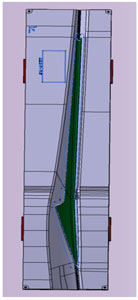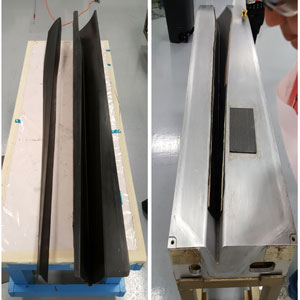SMART TOOL CAULS CASE STUDY

Female mold cavity CAD showing part
Manufacture of high performance, carbon fiber, reinforced epoxy components with tight radii, included corners has been a long standing manufacturing challenge faced by the aerospace industry. The primary difficulty associated with manufacture of these components is in the initial lay-up of the carbon/epoxy prepreg material into the tight corners. Both manual operators and automated layup equipment have difficulty physically accessing these tight areas, as well; the tack of the prepreg has an affinity for already laid up material on adjacent walls that also complicates the lay-up process. These difficulties often result in lay-up bridging into the corners that is difficult to compact out during cure. During cure, autoclave compaction pressure is applied normal to the entire part surface, including the walls adjacent to the corners. This application of pressure creates a pinching effect on the laminate, which makes it more difficult for the lay-up to consolidate into the corner void. The Smart Tooling Caul product is a match die caul product that is rigid at room temperature and elastomeric during laminate cure. The Smart Tool Caul product enables the application of the lay-up directly onto a rigid male inverse of the female cavity that can then be directly loaded into the female cure mold. The application of the laminate onto the inverse rigid male eliminates both the physical access and tack issues associated with manufacturing of tight radii, included corners. During cure the Smart Tool Caul transitions from a rigid state to an elastomeric state, enabling translation of the normal compaction force from the autoclave into the composite laminate.
This case study reviews the results of manufacturing attempts using conventional manufacturing methodologies in comparison to the Smart Tool Caul manufacturing methodology on components with tight radius corners, specifically the trailing edge pylon fairing. Details reviewed in the following case study outline increases in resultant part quality, as characterized by a significant reduction in interlaminate delamination’s and voids, as well as a manufacturing cost analysis between the conventional manufacturing processes and the Smart Tool Caul process.
PYLON FAIRING TRAILING EDGE INTITAL PROCESS

Previous Solution with Female Mold
The trailing edge pylon fairing was a double contour 8 ply epoxy/carbon fiber laminate with epoxy/copper mesh and epoxy/fiberglass surface plies. It contained a radius along the entire part length that was not constant, changing from .40” to .12” (10.2mm to 3mm). The pylon fairing came with inherited aluminum female tooling for hand layup and a vacuum bag autoclave cure. Carbon laminate had to be layed up into complex radii in the female cavity that created difficulties achieving proper ply consolidation and void prevention. The lay-up was a labor intensive process taking 6 hours to complete. A 50% scrap rate occurred from program start due to inter-ply delamination.
PYLON FAIRING TRAILING EDGE SECONDARY PROCESS
The inherited female aluminum tooling was converted into male tooling by taking the OML of the female aluminum tooling and reducing it by the laminates bulk factor (% ply consolidation reduction when laying plies over a male vs female tooling). A male prototype layup tool machined out of epoxy foam. The secondary process began by laying the plies in reverse order over the prototype epoxy foam tool and then transferring the plies to the female aluminum tool and then bagging for autoclave cure. This secondary process prevented inter-ply delamination due to laying up a complex geometry in a female tool, however, it created new issues with charge transferring. It also reduced the radius thickness from 36% to 22%. The secondary process reduced scrap rate from 50% to 30% and labor hours from 6 (67% eff.) to 4 hours (100% eff.).
USING A SMART TOOL THAT ACT AS A CAUL

Left: Smart Caul and Final Composite Part. Right: The Caul fitting inside the part
A female carbon fiber caul master was made off of the male prototype epoxy foam tool. Then a Smart Tool Caul was vacuum assisted resin transfer molded (VARTM) off the female carbon fiber Smart Tool master mold. Barrier ply release film was used to cover the Smart Tool Caul to ease the release from the cured laminate. This allowed the layup to be done over a rigid male Smart Tool Caul. Once the layup was complete (in reverse pattern order) on the rigid male Smart Tool Caul, it was dropped directly into the aluminum female cure mold. Unlike the secondary process, no transfer of the layup was necessary.
During cure, the Smart Tool Caul became elastic and was pressurized to translate the autoclave force to the laminate and into the radii, sufficiently compacting and consolidating the laminate. After de-molding, the Smart Caul was reformed under a vacuum bag at 250°F (121°C) in the Smart Tool master mold.
RESULTS
The Smart Tool Caul process significantly reduced scrap rate, going down to less than 3% and reduced labor hours down to 2 hours. The Smart Tool Caul process also significantly reduced radius thickness and increased overall ply consolidation by 36%, resulting in the desired part nominal thickness. The improved consolidation of the part eliminated the inter-ply delamination problem. The table below provides a manufacturing process results comparison.
| TOOLING PROCESS | SCRAP RATE | LABOUR HOURS (LAYUP) | RADIUS THICKNESS ABOVE NOMINAL |
|---|---|---|---|
| Female Aluminum Tooling | 50% | 6 (67% Eff.) | 36% |
| Male Prototype Epoxy Foam Tooling | 30% | 4 (100% Eff.) | 22% |
| Smart Tool Caul | <3% | 2 (200% Eff.) | 0% |
ENABLING THE BENEFITS OF SMART TOOLING
Laying up composite plies into deep female corners creates an issue of possible corner bridging and resin rich areas. Even the most experienced composite technicians still have difficulty in laying-up into deep sharp corners. This is where a Smart Tool Caul adds value into the manufacturing process. The Smart Tool Caul is manufactured to the net shape of the IML part line, which enables lay-up to be performed on a male IML surface instead of a female OML surface. Corner lay-up can be easily performed on a male IML tool, where the plies can be placed tightly over and around corners to eliminate corner bridging and resin rich areas in the final part. The Smart Tool Caul surface is applied with a permanent barrier ply, like Airtech Tooltech, which will provide easy release from the composite part after cure. The Smart Tool Caul is also significantly lighter, at 1.13g/cm3, than aluminum or steel, which has densities of 2.70 g/cm3 and 7.75 g/cm3 respectively. Not only does the Smart Tool Caul have the advantage of a lower specific weight, it is also manufactured to be approximately 0.100” thick which translates into a very light and maneuverable caul, yet still rigid enough for lay-up.
Smart Tool Cauls also add value to the manufacturing process during the cure cycle. The Smart Tool Caul and lay-up is bagged down to the cure mold and vacuum is pulled to remove all the air. The cure mold is manufactured to the OML of the final part. During cure the Smart Tool Cauls are above their Tg, which means that they go from rigid to an elastic state. Having the vacuum pulled on the part will create a force of 14.7 psi on the Smart Tool Caul that will be directly translated evenly over the entire lay-up. If extra force is needed in order to fully consolidate the plies, an autoclave can be used for the cure and an appropriate pressure can be applied to insure composite laminate consolidation. Once the part is cured, the Smart Tool Caul can be removed either cold if there are no trapped features or hot if the geometry has trapped features.
Smart Tooling provides formable, reusable tooling solutions for manufacturing composite parts with complex geometries for the aerospace & defense industry. Smart Tools improve quality, reduce labor hours, decrease consumables, and increase throughput – essentially, Smart Tools enable the manufacturing of composite parts better, cheaper, and faster.
Smart Tooling’s Shape Memory Polymers are designed to be aerospace-grade RIGID epoxies at room temperature, and highly FLEXIBLE elastomers when heated, eliminating the need for expensive, laborious, tedious, dirty, and challenging solutions such as melt-out foam, metal breakdown tools, rubber bladders, or washout tooling.
We offer total solutions for the manufacture of your composite part, including custom tooling engineering and design, fabrication of molds, Smart Tool fabrication, initial composite part manufacturing, custom standard operating procedures, onsite start-up support and training, and any future training or support.
Browse our of library of other case studies and applications. For more information on how Smart Tools work and their applications click here.
Share this Post


